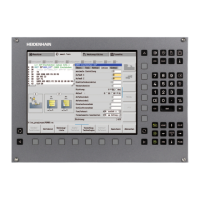January 2012 6.16 The Control Loop 933
Synchronous spindle/torque motor
MP_ampVoltProtection = installed – mode 2
((13) in the commissioning flow chart)
When you have set the desired acceleration (and rounding, if required) for the
respective drive, test if the motor accelerates to the required final speed with
a steady increase in acceleration. "Steady increase in acceleration" means that
there are no drops in the acceleration curve. The actual acceleration usually
declines with increasing speed, however.
Synchronous spindle/torque motor
MP_ampVoltProtection = installed – mode 2
((14) in the commissioning flow chart)
Drops in the acceleration curve indicate an excessive magnetizing-current
consumption. You can see this if it exceeds 90 % of the maximum current of
the drive. You can display the magnetizing current on the internal oscilloscope
of the control.
Synchronous spindle/torque motor
MP_ampVoltProtection = installed – mode 4
((15) in the commissioning flow chart)
If the maximum current is limited by the power module (Imax of power
module << Imax of motor) it can make sense to use a more powerful power
module. As an alternative you can use the entry MP_ampVoltProtection =
installed – mode 4 to activate an algorithm to reduce the magnetizing
current.
Synchronous spindle/torque motor
MP_ampVoltProtection = installed – mode 4
((16) in the commissioning flow chart)
If you can attain a steady actual acceleration to the final speed with
MP_ampVoltProtection = installed – mode 4 (or by installing a larger
power module), there are enough reserves again for the magnetizing
component—the setting of MP_ampVoltProtection (=installed – mode 4)
is completed here.

